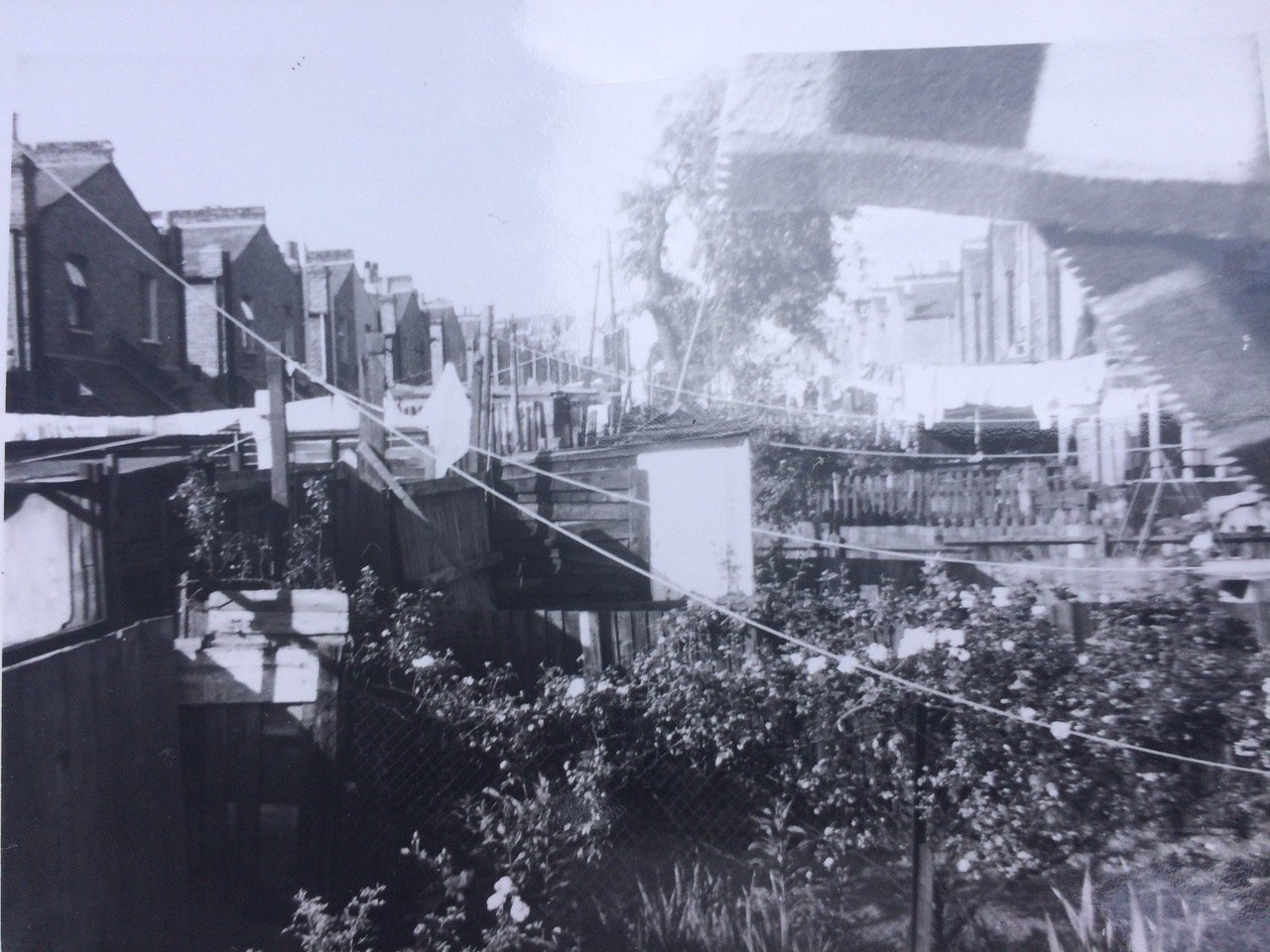How you relate, authentically or not, to your material.
View from the writer’s backyard. South London. Early 60s. Photo: Peter Markham
There’s a faculty member at the film school in which I used to teach, a rare educator of perennial popularity from whom I learned much. He talks about what material you can relate to authentically. When you carry a connection to that story rooted in your own history and experience, he says, then that world, that story, its milieu, its characters, the emotions it brings to the screen will ring true. When you have nothing in common by contrast, but only affect a bond — in short, when you don’t know what you are talking about — those emotions, no matter how heightened, how intense, how strident, are likely to prove false.
The term he uses, to describe the universe of the self from which this authentic conduit to material springs, is your backyard. It conjures a vision of a specific, familiar place from your past. This vignette in your head, resonates as synecdoche, metaphor, and symbol too. Synecdoche because as a part of your childhood home, it stands for the entire place, your first neighborhood, first town, first city etc., etc. Metaphor because its image conjures images of other things, of particular objects and items, and of people — parents, parental figures, siblings, neighbors, friends at school, the bullies you endured, or the unfortunates you bullied — should you have been so inclined. Symbol because it conveys abstract entities — your formative history, your psyche, your place in the world and your perspective on it.
Michael Haneke — for me one of the best living filmmakers on the planet — once said: My students… pitch only the gravest of topics. For them it’s always got to be the Holocaust. I usually tell them, ‘Back off’. You have no idea what you are talking about. You can only reproduce what you read or heard elsewhere. Others who actually lived through it can tell it so much better than you ever could. Try to create something that springs organically from your own experience.
Then came László Nemes with Son of Saul…
Write what you know, we are told. Don’t meddle with stuff that lies outside your experience. Maybe, but then… how do we define ‘what we know.’ Is it a place, a backyard? Is it a community, a milieu, a culture? My own childhood was spent in South London in a flat with no bathroom, no inside loo, no fridge, no washing machine, no phone, and with a minimal backyard bordered by broken fencing with a rotting shed cobwebbed to the back. 49 pupils to one teacher in my class at the forbidding primary school down the end of the street. Then there were my grandparents, aunts and uncles north of the Thames with their glottal-stopped London patois. The smell of boiled bacon, milk stout, mustiness, of old, cloacal London itself. The family’s criminality, masked by jollity was kept from me at the time — just as well too — but it was there alright, lurking like a shadow denied its casting over the street.
Was the combination of all that that my ‘backyard’ then? Could a filmmaker coming from there relate only to tales of socially disadvantaged Londoners in grim settings south and north of the Thames? Or do you get a choice of venues? Can you pick and choose somewhere else, somewhere you might have lived later on?
My family moved to the country when I was twelve, to a village not far from the sea and set amidst heathland and forest. Now we had a bathroom, an indoor loo, a back garden rather than a yard. After a few years, we even had a phone. Eventually my Dad had a car, even if it had seen better days by the time, with varying degrees of success, it ferried us around. I was regarded as a ‘townie’ by the local boys, though they were kinder than the toughs back in London. They spoke with a Hampshire burr, so my London speech stood out. They would say cahnrrr. I would say kawnah. The word as written is corner. I attended the local grammar school where again the air of gentleness contrasted to the murderous machismo of my London grammar. And there were girls there, and I was hitting my teens… So might this not equally have constituted my ‘backyard’?
Or is what we know not a place at all, not living conditions, not a social class, not the people around us, not our position in society when we were growing up, not even our acculturation — although I’m not denying the impact of ethnicity and history on us and our sense of identity — but something more? Because — doesn’t what we ‘know’ lie within us?
It’s this that we have a sense of. It makes us what we are, even controls us if we’re not careful — and too often even when we are. And it’s that sense which suggests to us whether we can relate to a story, to its characters, to the questions it raises, or even to something we can’t pin down but know the film has to be made in order to find it. The instinct — the hunch, isn’t that our guide to authenticity?
Homer was never at Troy, Borges said. The towers of Ilium were not Homer’s backyard, yet didn’t he, or they — if a composite of writers (or she, if that was the case) — rattle off a couple of more than epic poems to weather the millennia? Wouldn’t Homer have had to relate authentically to his material to bring off this feat? We can never know, of course, how he/she/they connected to those stories, but surely it wasn’t because they’d spent their childhood holed up in the belly of a wooden horse.
So what prompted me to list details of my early years then? Isn’t it because I feel so strongly about those experiences? That backyard squashed between the thin strips of yard to either side — didn’t I post a photo of it at the top of this article. Why? It’s an element of myself, that’s why. It brings out emotions in me. Pain, joy, fear, claustrophobia, calm, loss, yearning, wonder…
Write what you feel! says filmmaker Rosita Lama Muvdi. Yes. Your backyard is what you feel. The same goes for filmmaking in general, not only writing, because if you don’t feel your connection, how can your audience feel the film? And when you work with what you feel you can work with what you don’t know but can imagine. We can’t know the past, more so the future, but if we can feel them we might bring them — or at least their approximations — to life on the screen.
It’s not always comfortable though, what you feel. Maybe it should never be — at least when you’re looking for a productive relationship with your material. W.B. Yeats, in his poem The Circus Animals’ Desertionwrote of the foul rag and bone shop of the heart. Isn’t that the place that constitutes the backyard my former colleague was promoting? Our soul? The soul that, no matter how messed up, how disordered, how despoiled, that cries out for stories, characters, images, for form — whether skewed, elegant, or both — and for voice, in order that it might speak out, both to our fellow human beings, and to itself.
Because a soul that speaks to itself, speaks to us all.
Peter Markham January 2022












